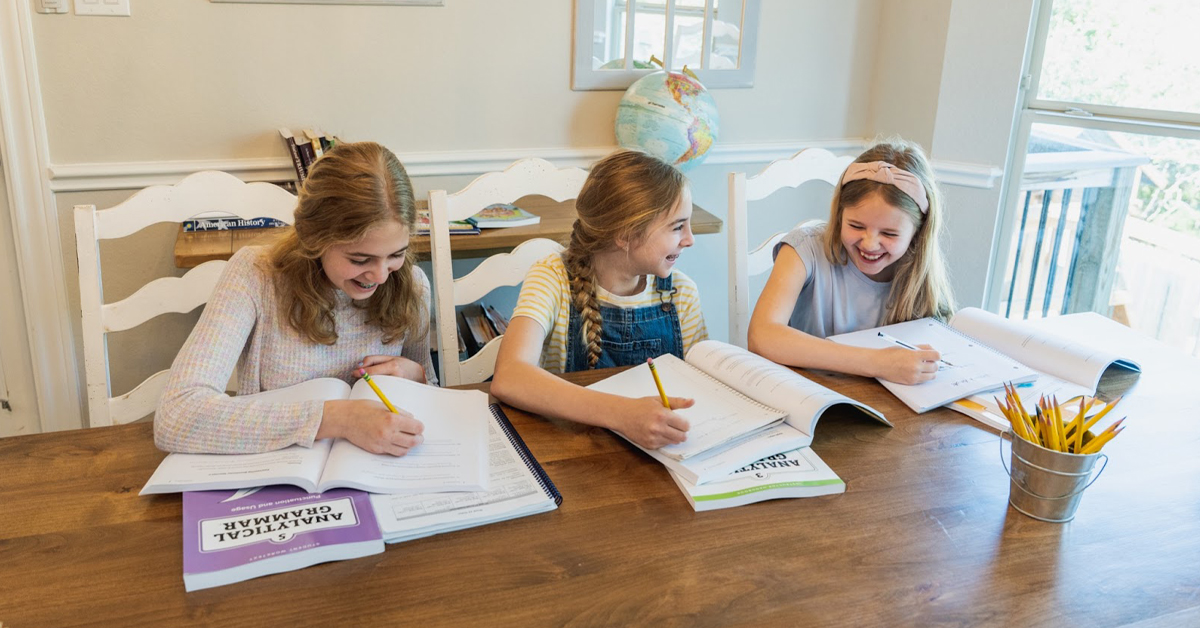
Have you ever seen those booths where they turn on a high-powered fan and you try to catch the money that’s swirling around you? That’s probably the best visual I can think of for trying to homeschool multiple children simultaneously.
I’ve often thought of the lovely, Norman Rockwell-esque photos of a peaceful mother sitting quietly on the sofa with her children gathered around and listening attentively as she instructs them. That’s what I thought homeschooling my children would be like. My personal reality was much more like a Ronda Rousey tag-team event, with me sparring with one child while the others either looked on or went off to cause some sort of mayhem.
All kidding aside, there is a real art to teaching more than one child. In this blog, I’m sharing five tips for homeschooling multiple ages successfully.
5 Tips for Homeschooling Multiple Ages and Ability Levels
From my 21 years of experience as a homeschooling mother, here are five tips that helped me juggle the academic needs for each of my children.
1) Set Realistic Goals
Planning ahead for your day can be the most valuable investment of your time. Before you break out the books, take a few minutes to look at each child’s curricula. Decide what absolutely must be completed and what would be nice if it were completed that day. In my experience, reading, math, and spelling were the “absolute musts.” Whatever the must-do tasks are for you, they should be the ones you tackle first. If you still have time once those are finished, plan to move on to the less important tasks. Recognize that, on any given day, you likely aren’t going to be able to accomplish all that you plan. Homeschooling multiple ages is challenging, and crossing even one must-do off of your list is a victory.
2) Teach Some Subjects Together
If your children are close in age, then there are some serendipities of being able to teach certain subjects together or provide direction to more than one child at a time.
History, science, and even reading are all subjects that lend themselves to group activities. Math is the one subject you will have to teach individually, so be sure to dedicate one-on-one time for each child’s math instruction.Additionally, I suggest you start with your eldest child in mind when planning your academics. Young children catch a lot of what their older siblings are learning. Remember, you have the least amount of time left with your eldest child!
3) Get Your Supplies Ready
Make sure you have everything needed for a lesson available from the start. Does the lesson require scissors, a protractor, or a glue stick? If you gather all of the necessary materials before the lesson begins, then you won’t waste time tracking down materials while your kids wait. Young students don’t typically have the attention spans for waiting, so it’s better to be prepared in advance than have to reel them back in.

4) Encourage Collaboration
When possible, have your children work together on an activity or project. I worked hard to help my children learn to collaborate in lessons rather than competing with each other. I always felt that competition between siblings was dangerous, and I’d much prefer them to speak words of encouragement to each other. You know which siblings will work well together and which pairings will end up angry and exasperated. When possible, pair up those who work well together.
5) Keep Little Ones Occupied
Have a plan in place to keep little minds (and hands) busy if they aren’t learning. I had “doing boxes” in my homeschool room that housed special toys, puzzles, or games that my children could only access while I was working with a sibling. You know your children best, so think of what interests them and what activities would keep them content until you’re able to do schoolwork with them. Reading, crafting, and imaginative play are all valuable uses of free time.
Homeschooling multiple ages, abilities, and interests is like riding a wave. If you can stay on top of the wave, it’s fun and exciting. But occasionally, the waves smack you right down. Don’t be discouraged when this happens. Take a deep breath, dive back in, and enjoy the ride. Remember, every day is a gift, and this time will pass swiftly.




Leave a Reply